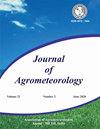西孟加拉邦南部标准化降水指数(SPI)的变化及其对黄麻产量的影响
Q3 Agricultural and Biological Sciences
引用次数: 0
摘要
西孟加拉邦是该国黄麻原纤维的主要生产地。识别和管理黄麻生长期间的干旱期至关重要,因此有必要制定应急作物规划,以提高生产率。考虑到这一点,我们计算了代表西孟加拉邦南部五个不同地区的五个地点的标准化降水指数 (SPI)。这五个地点分别是巴拉克波尔(北 24 帕尔干纳斯区)、帕纳加尔(伯德旺区)、巴加提(胡格利区)、克里希纳加尔(纳迪亚区)和乌鲁贝利亚(豪拉区)。与降雨相关的干旱指数(SPI)以 1 个月和 3 个月为间隔进行计算,以确定适用于季节性作物的短期干旱和中期干旱。对 SPI 值的趋势分析表明,北 24 巴尔加纳斯和纳迪亚地区在黄麻生长期的干旱程度加剧。纳迪亚地区的短期和长期干旱程度都有显著增加。除 Howrah 外,所有研究地点的减产指数都与 SPI 值密切相关。在黄麻生长初期安排灌溉有助于作物应对该地区季风的中断。本文章由计算机程序翻译,如有差异,请以英文原文为准。
Variation of standardized precipitation index (SPI) over southern West Bengal and its effect on jute yield
West Bengal is a key producer of raw jute fiber in the country. Identifying and managing dry spells during the jute growing period is crucial, necessitating contingency crop planning for enhanced productivity. Keeping this view in mind, standardized precipitation index (SPI) was calculated over five locations, representing five different districts of southern West Bengal. These locations are Barrackpore (North 24 Parganas District), Panagarh (Burdwan District), Bagati (Hooghly District), Krishnanagar (Nadia District) and Uluberia (Howrah District). This rainfall dependent dryness index (SPI) was calculated in 1 month and 3 months interval to identify short term dryness as well as mid-term dryness, applicable for seasonal crops. The trend analysis of the SPI values indicated that North 24 Parganas and Nadia experienced increased dryness during vegetative phase of Jute. Nadia district showed a significant increase in both short term and long-term dryness. The yield reduction index is well correlated with SPI values in all the study locations except Howrah. Arrangement of irrigation during the early stages of Jute can help the crop to cope up with the break of monsoon in this region
求助全文
通过发布文献求助,成功后即可免费获取论文全文。
去求助
来源期刊

Journal of Agrometeorology
农林科学-农艺学
CiteScore
1.40
自引率
0.00%
发文量
95
审稿时长
>12 weeks
期刊介绍:
The Journal of Agrometeorology (ISSN 0972-1665) , is a quarterly publication of Association of Agrometeorologists appearing in March, June, September and December. Since its beginning in 1999 till 2016, it was a half yearly publication appearing in June and December. In addition to regular issues, Association also brings out the special issues of the journal covering selected papers presented in seminar symposia organized by the Association.
 求助内容:
求助内容: 应助结果提醒方式:
应助结果提醒方式:


